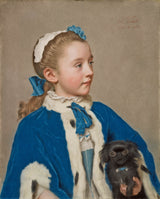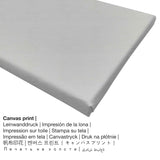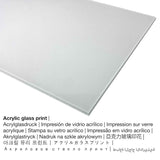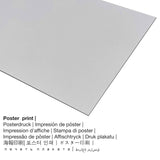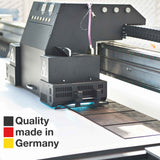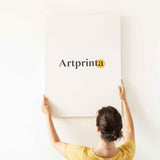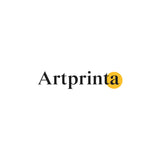Jean-Etienne Liotard, 1756 - Eserese nke Maria Frederike van Reede-Athlone na Seven - ọmarịcha nka.
Ụtụ gụnyere. Mbupu gbakọrọ na ndenye ọpụpụ.
Portrait of Maria Frederike van Reede-Athlone at Seven painted by the Swiss painter Jean-Etienne Liotard as your own artprint
The more than 260 year old artwork was painted by the Swiss artist Jean-Etienne Liotard in 1756. Besides, this artwork is included in the digital collection of The J. Paul Getty Museum. With courtesy of Ụlọ ihe ngosi nka nke J. Paul Getty (ikike ngalaba ọha).Akụkọ nke ọrụ nka bụ ihe ndị a: . E wezụga nke a, nhazi nke mmepụta dijitalụ bụ Eserese ma nwee oke nke 1: 1.2, nke pụtara na ogologo bụ 20% mkpụmkpụ karịa obosara.
Họrọ ngwa ngwaahịa gị
Maka mbipụta nka ọ bụla, anyị na-enye nha & ihe dị iche iche. Ka ị kwekọọ n'ihe ị chọrọ nke ọma, ị nwere ike họrọ n'ime nhọrọ nhazi ngwaahịa ndị a:
- Mbipụta iko acrylic na-egbuke egbuke: The acrylic glass print, which is sometimes referred to as a plexiglass print, will transform your favorite artwork into décor. The great upside of a plexiglass print is that contrasts and color details become recognizeable with the help of the subtle tonal gradation in the print. The real glass coating protects your chosen art print against light and heat for many years to come.
- Akwụkwọ mmado ebipụtara (ihe kwaaji): The poster print is a printed flat canvas with a granular finish on the surface. It is used for putting your art print with the help of a special frame. Please note, that depending on the absolute size of the canvas poster print we add a white margin of approximately 2 - 6cm round about the artwork to facilitate the framing.
- Mbipụta kanvas: The canvas print, which shall not be confused with a real artwork painted on a canvas, is a digital image printed on an industrial printer. A canvas has a distinctive look of three dimensionality. Canvas prints are relatively low in weight, which implies that it is easy and straightforward to hang your Canvas print without additional wall-mounts. Canvas prints are suitable for any kind of wall.
- Mbipụta nke aluminom: An Aluminium Dibond print is a print material with a true effect of depth, which makes a fashionable look throuch a surface structure, which is non-reflective. The Aluminium Dibond Print is your ideal introduction to reproductions with aluminum. For our Direct Aluminium Dibond print, we print your chosen artpiece on the surface of the aluminum. The white & bright parts of the original artpiece shine with a silk gloss but without the glow. Colors are luminous, the details of the print are clear and crisp.
Important information: We try everythig possible to depict the art products as accurately as possible and to display them visually in our shop. Although, the colors of the print products, as well as the imprint might differ somehwat from the presentation on the device's monitor. Depending on the screen settings and the nature of the surface, not all colors are printed 100% realistically. Considering that all the fine art prints are processed and printed by hand, there may as well be slight variations in the exact position and the size of the motif.
Tebụl ngwaahịa
| Nkewa bipụta: | nka nka |
| Mmeputakwa: | dijitalụ mmeputakwa |
| Produzọ mmepụta: | Mbipụta UV / dijitalụ |
| Mmalite ngwaahịa: | emepụtara na Germany |
| Stockdị ngwaahịa: | a na-achọ |
| Ihe eji eme atụmatụ: | nka mgbidi, gallery mgbidi |
| Ndozi onyonyo a: | nhazi ihe osise |
| Oke akụkụ: | 1: 1.2 |
| Ihe: | ogologo bụ 20% mkpụmkpụ karịa obosara |
| Akụrụngwa dị: | ígwè obibi akwụkwọ (aluminium dibond), ebipụta canvas, mbipụta enyo acrylic (nwere ezigbo mkpuchi iko), mbipụta akwụkwọ mmado (akwụkwọ kwaaji) |
| Nhọrọ nke Canvas Mbipụta (akwa akwa na etiti ihe ndọtị): | 50x60cm - 20x24", 100x120cm - 39x47", 150x180cm - 59x71" |
| Mbipụta iko acrylic (nwere ezigbo mkpuchi iko) nhọrọ nha: | 50x60cm - 20x24", 100x120cm - 39x47" |
| Nhọrọ nke mbipụta akwụkwọ mmado (akwụkwọ kwaaji): | 50x60cm - 20x24", 100x120cm - 39x47" |
| Ụdị mbipụta aluminom: | 50x60cm - 20x24", 100x120cm - 39x47" |
| Nhazi mbipụta nka: | adịghị |
Data ndabere na mpempe nka izizi
| Aha nka: | "Portrait of Maria Frederike van Reede-Athlone at Seven" |
| Nhazi nka: | sere |
| Okwu mkpokọta: | nka ochie |
| Narị afọ nka: | 18th narị afọ |
| Afọ nka: | 1756 |
| Afọ nka: | gbara afọ 260 |
| Ụlọ ihe ngosi nka / ebe: | Ụlọ ihe ngosi nka nke J. Paul Getty |
| Ebe ebe ngosi nka: | Los Angeles, California, Njikota Obodo Amerika |
| Weebụsaịtị nke ihe ngosi nka: | Ụlọ ihe ngosi nka nke J. Paul Getty |
| Licensedị ikike: | ngalaba ọha |
| Site n'aka: | Ụlọ ihe ngosi nka nke J. Paul Getty |
Tebụl nchịkọta ihe nkiri
| Ihe nkiri: | Jean-Etienne Liotard |
| Aha nka ndị ọzọ: | Jean-Étienne Liotard, Liotard, Liotard Jean-Étienne, Liotard Giovanni Stefano, Jean Etienne Liotard, jean etienne liotart, j. liotard, Liotard Jean Étienne, j. e. liotard, liotard j. e., Liotard John Stephen, etienne liotard, Leotard, Léodard, Liotard Jean-É., jan etienne liotard |
| okike nke onye nka: | nwoke |
| Obodo onye nka: | Swiss |
| Ọrụ: | onye na-ese ihe |
| Obodo onye nka: | Switzerland |
| Nhazi nke onye nka: | nna ukwu ochie |
| Akwụsị: | 97 afọ |
| Amụrụ n'afọ: | 1692 |
| Ebe omuma: | Geneva, Geneve, Switzerland |
| Afọ nwụrụ: | 1789 |
© Nwebiisinka nke | Artprinta.com (Artprinta)
Original artwork specifications from the museum's website (© - The J. Paul Getty Museum - www.getty.edu)
Changing attitudes towards children and the emergence of a large middle class in eighteenth-century Europe increased the demand for portraits of children such as this one. Maria Frederike, the seven-year-old daughter of an aristocratic Dutch family, looks off to the side in a three-quarter view. Lost in thought, she is composed yet somewhat shy in comparison to her dog, who stares out with unabashed curiosity. With startling naturalism, Jean-Étienne Liotard captured her youth and beauty, setting off her eyebrows, lashes, and lustrous hair against her soft, fresh complexion.
Liotard developed remarkable technical skills in the difficult medium of pastels. Brilliantly describing surfaces and defining volume through subtle gradations of color, he depicted forms, textures, and the play of light with great immediacy. He favored using pastels, especially for portraits of children, because they could be manipulated with greater speed and ease, had no odor, and allowed for frequent interruptions. (Source: J. Paul Getty Museum)

